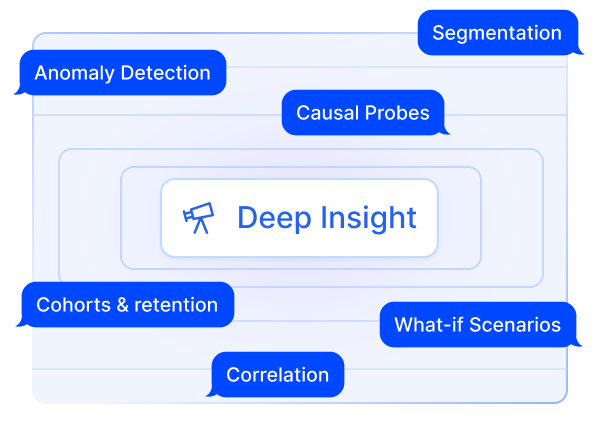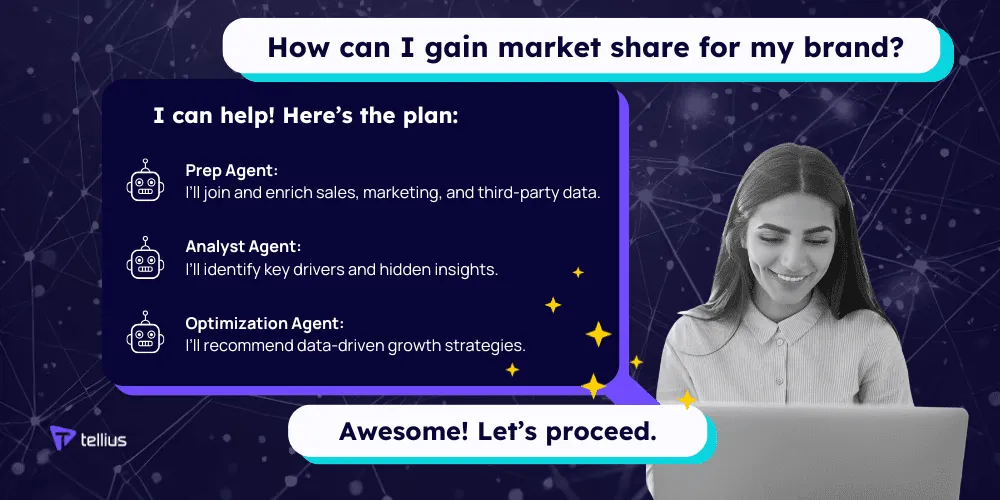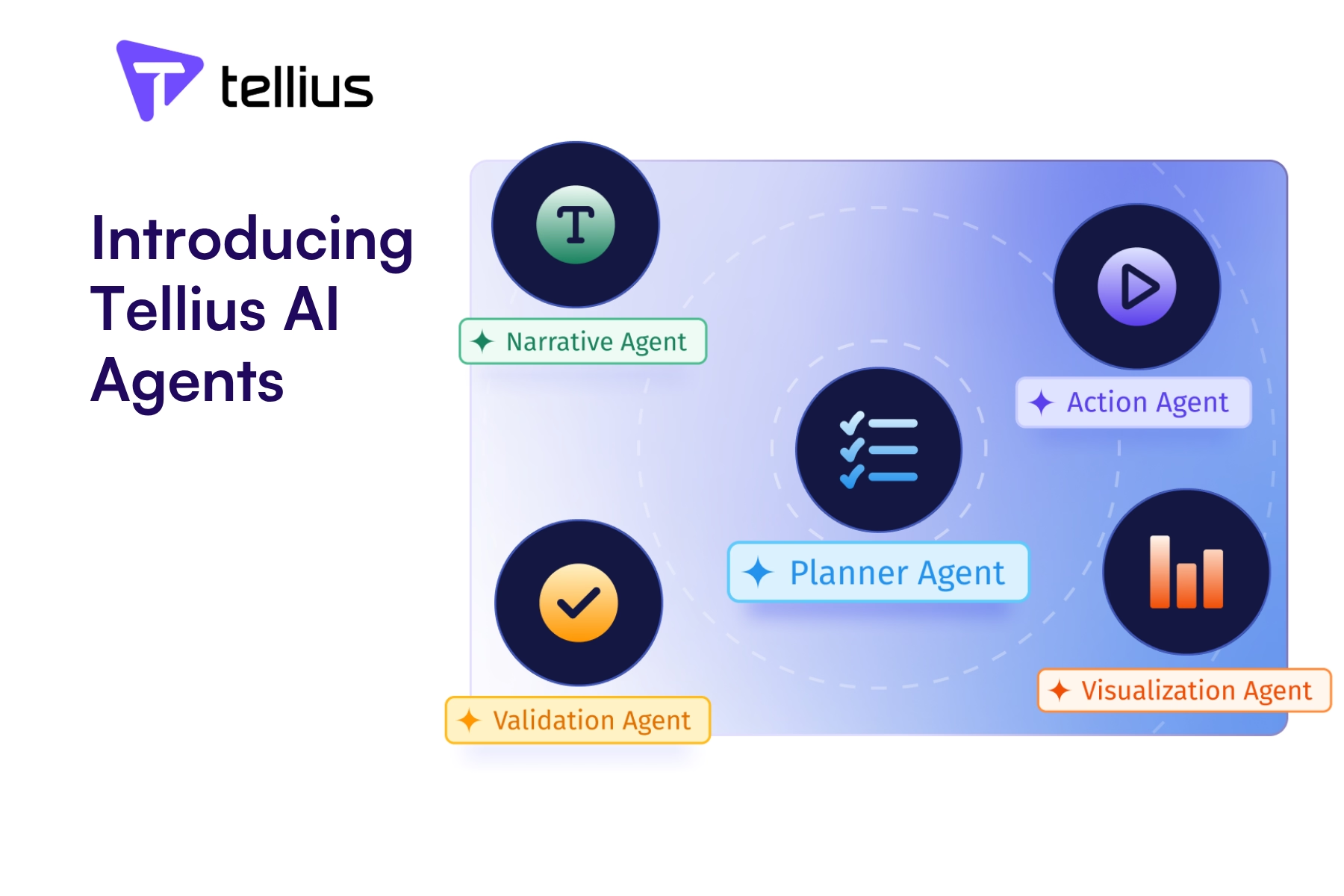Introducing Tellius Agent Mode: Agentic Analytics That Actually Does the Work
%20(37).png)
Agentic AI—next-gen AI that reasons, plans, and executes—has evolved from research experiments to production-grade systems at leading enterprises. But here's the problem: agentic automation at scale without deep analysis is just faster mistakes. In this post, we'll show you how we solved this—building an AI analyst that grounds every action in rigorous reasoning, turning your toughest analytical workflows into single-turn conversations, as well as repeatable deterministic custom workflows. Whether you're diagnosing revenue drops, forecasting territory performance, or running compliance analyses, you'll see how Agent Mode delivers the depth of a senior analyst with the speed of automation.
The 20-Question Trap vs. One-Turn Analysis
Most conversational analytics tools force you into a frustrating loop: ask a question, get a surface answer, ask a follow-up, get another fragment, repeat 15 more times. By turn 20, you've forgotten what you were even trying to solve.
Here's what that looks like in practice:
Before Agent Mode (traditional chat):
You: "Why did revenue drop in Q3?"
AI: "Q3 revenue was $8.2M, down 8% from Q2."
You: "Which regions drove the drop?"
AI: "West region declined 12%, Northeast declined 6%..."
You: "What caused the West decline?"
AI: "Let me check product categories..."
You: "Can you segment by customer type too?"
AI: "Sure, here's the breakdown..."
You: "What about timing—when did it start?"
AI: "The decline began in mid-August..."
[15 more turns later, you're exhausted and still don't have a full answer]
With Agent Mode (one turn):
You: "Why did revenue drop in Q3, and what should we do about it?"
Agent Mode: [Autonomously plans and executes 7-step workflow]
→ Q3 revenue declined 8.2% ($8.2M vs $8.9M in Q2)
→ Timing: Steepest drop mid-August (−12% WoW)
→ Drivers ranked by impact:
1. West region fulfillment delays (−$420K, 60% of gap)
2. BOGO promo end in Electronics (−$180K, 26%)
3. Competitive pressure in Northeast (−$98K, 14%)
→ Recommended actions with ROI:
• Expedite West hub staffing (ROI: 3.2×, ETA: 2 weeks)
• Extend Electronics promo selectively (ROI: 2.8×, ETA: 1 week)
• Launch Northeast counter-messaging (ROI: 2.1×, ETA: 3 weeks)
→ Projected recovery: +$530K within 6 weeks
Agent Mode doesn't just answer your question—it answers the question behind the question. It knows you don't just want "what happened," you want when, why, who drove it, and what to do next. That's the difference between chat and analysis.
Meet Agent Mode: Your Expert Data Analyst and Data Scientist in One
Agent Mode gives Kaiya full agentic capabilities—enabling it to dynamically plan, execute, and refine complex analyses just like a human analyst or data scientist would.
Instead of simply translating a question into SQL, Agent Mode understands the "why" behind the question. It reads between the lines, identifies what you're really trying to achieve, and builds a multi-step plan to deliver not just an answer—but a story.
.gif)
- Ask "What happened?" → Kaiya shows you the metrics.
- Ask "Why did this happen?" → Kaiya runs correlation, segmentation, and variance analysis.
- Ask "How can I improve this?" → Kaiya simulates scenarios and recommends actions.
This is what we mean by Agentic Analytics—where AI doesn't just describe your business, it diagnoses and advises it.
Kaiya can now run virtually any kind of analysis—from revenue trend decomposition to call execution modeling to territory performance forecasting—all autonomously.
With Agent Mode, you have an expert data analyst and data scientist at your fingertips.
Multi-Agent Architecture That Does Analytics Work
Agent Mode is a coordinated multi-agent system where specialized agents handle distinct parts of the analytical workflow:
Planner Agent
Parses intent, disambiguates the task, identifies required data sources, and maps the execution path. It's imbued with your company's context—fiscal calendars, metric definitions (e.g., net revenue = gross sales − returns − discounts), hierarchies, and preferred breakdowns. The Planner ensures we're solving the right problem before we start executing.
Analyst Agent
Executes the plan using the right tool for each step—SQL for warehouse-native queries, Python for statistical methods SQL can't cover (changepoint detection, contribution/variance with volume weighting, partial correlations, causal probes, forecasting with confidence intervals). A built-in classifier automatically routes each sub-task to the optimal execution path. No configuration required from you.
Validator Agent
Enforces guardrails before surfacing results—row-level security policies, sample-size checks, fan-out/chasm avoidance, fiscal calendar mappings. Every output is auditable, reproducible, and governed by your existing data security model. The Validator ensures we're not just fast—we're correct.
The Result
This isn't bolt-on AI. It's Kaiya evolved—our deterministic analytics engine combined with agentic reasoning to deliver one narrative with:
- Timing (when it moved)
- Magnitude (how much)
- Ranked drivers (why, in order of impact)
- Confidence (with receipts so you can trust it)
- Next actions (what to do about it)
Our semantic layer and knowledge graph encode your metric logic and business relationships, so Kaiya chooses the right breakdowns automatically and returns governed, explainable outcomes at unprecedented speed.
Agent Mode = Two Modes, One System
Agent Mode gives you flexibility when you need to explore and consistency when you need to scale. It's not either/or—it's both, working together.
Mode 1: Deep Insights forAdaptive Exploration

When you need to explore, diagnose, or discover—Agent Mode plans and executes multi-step workflows on the fly. No setup, no preconfiguration. Just ask, and Kaiya dynamically sequences the analysis.
Use it for: Root-cause investigations, exploratory "why did this happen?" queries, one-off strategic questions.
From a single prompt, Kaiya can drive:
- Variance & contribution (what moved, when, and who drove it)
- Cohorts & retention (who sticks, who churns, why)
- Anomaly detection (spikes, dips, outliers worth attention)
- Correlation & association (what moves together vs. noise)
- Causal probes (is X likely driving Y?)
- Forecasts with intervals (what's next, with confidence)
- Segmentation & clustering (meaningful groups, not guesswork)
- Benchmarking & cohorts (this region/team vs. peers)
- What-if scenarios (change the inputs, see the outcomes)
Kaiya chooses the right path per question and returns governed results with full auditing, data-source queuing, row-level policies, and fiscal calendars honored.
Mode 2: Custom Workflows for Governed Repeatability

When you've found an analysis that works—or when your team needs to run the same playbook consistently (compliance checks, quarterly forecasting, territory reviews)—save it as a Custom Workflow.
With Custom Workflows, you define your analytical approach in natural language—step-by-step. Kaiya then ensures those steps are followed precisely every time the workflow runs.
Use it for: Standardized KPI reviews; repetitive analytic deep dives that you only do on a monthly/quarterly basis
Real example: A Pharma market access team runs a quarterly "Patient Initiation Deep Dive" workflow that:
- Compares expected vs. actual initiations by payer segment
- Runs contribution analysis on access policy changes
- Attributes gaps to PA friction, affordability, HCP awareness
- Outputs ranked action plans with ROI estimates
The first time, they used Deep Insights to explore. Now, every quarter, they run the saved Custom Workflow in minutes—same depth, same accuracy, consistent insights across the team.
It's the best of both worlds:
- Agentic intelligence when you need adaptive exploration
- Predictable structure when you need repeatable rigor
Early Results: Real Impact, Real Numbers
Our early access users of Agent Mode have delivered insights that once required weeks of manual effort—often uncovering opportunities and risks that would have been missed entirely.
Fortune 500 Retailer — Supply Chain Analytics
A global retailer used Agent Mode to diagnose a Q3 cancellation-rate spike. What used to require a 3-analyst, 2-week effort—pulling data from multiple warehouses, running cohort analyses, building attribution models—was completed in 4 minutes.
Agent Mode identified:
- Timing: Mid-August inflection point
- Magnitude: −8.2% WoW cancellation rate spike
- Ranked drivers:
- Fulfillment delays in West region (60% of gap)
- BOGO promo end in Electronics category (26%)
- Competitive pressure in Northeast (14%)
- Recommended actions: Hub staffing changes (ROI: 3.2×), selective promo extension (ROI: 2.8×), regional counter-messaging (ROI: 2.1×)
Result: The merchant ops team implemented changes within 72 hours, recovering an estimated $1.2M in prevented cancellations over the following 6 weeks.
Top-10 Pharma — Market Access Analysis
A leading pharmaceutical brand is exploring Agent Mode to answer: "Which payer segments improved access for our brand in FY24 but didn't translate into proportional patient initiations—and why?"
The analysis surfaced that Commercial PPO had a ~2,000-script gap between expected and actual patient starts, driven primarily by:
- HCP awareness lag (47% of gap)
- Patient affordability friction (31%)
- PA/step-edit delays (15%)
- Competitive pressure (7%)
Agent Mode didn't just identify the problem—it quantified each barrier's contribution and recommended targeted interventions: co-branded payer communications, copay SMS alerts, and field rep re-engagement blitzes, each with projected lift and ROI.
What used to take: A cross-functional team 3+ weeks of manual analysis
With Agent Mode: One prompt, comprehensive answer in minutes
The Common Thread
As one beta user put it:
"Kaiya didn't just answer my question—it answered the next five I was about to ask."
Agent Mode delivers the depth and rigor of expert analysis with the speed and accessibility of conversation.
From "What" to "Why" to "How"
This release fulfills our long-standing vision at Tellius—helping enterprises go from What happened? → Why did it happen? → How can we make it better?
What: Automated analytics at scale
Agent Mode handles compound, multi-metric, multi-dimension requests and returns relevant, accurate results with timing, magnitude, drivers, and next steps—from a single prompt. It executes joins, subqueries, dynamic formulas, and nested aggregations across billions of rows of governed enterprise data.
Why: Agentic insights that uncover root causes
Agent Mode doesn't stop at "revenue dropped 8%." It decomposes the variance, runs contribution analysis with volume weighting, identifies change points in the timeline, correlates the shift with operational and market factors, and ranks drivers by impact—quantifying exactly which segments, products, or regions explain the movement and by how much.
How: Prescriptive guidance and actionable simulations
Agent Mode doesn't leave you with a diagnosis—it delivers a treatment plan. It models what-if scenarios, estimates lift and ROI for each intervention, and prioritizes actions by impact, cost, and time to value. You get a playbook, not just a report.
It's analytics that thinks with you.
Agent Mode remembers prior runs, understands your role and goals, and builds on past conversations. Each question advances the last, creating continuity that compounds over time—not isolated one-off answers.
Why Agent Mode Matters
Agent Mode democratizes deep analytics without sacrificing rigor. Here's what that means for different roles in your organization:
For Business Users
Stop waiting on analysts for every follow-up question. Ask your question in plain English—no matter how complex—and get multi-layered answers with timing, drivers, and recommendations. No SQL. No dashboards. No 20-question sessions. Just the insight you need to make the call.
For Analysts
Escape the "data janitorial" cycle. Let Agent Mode handle routine deep dives—the variance decompositions, cohort analyses, and attribution studies that eat up 60% of your week. Focus your time on strategy, storytelling, and high-impact initiatives that require human judgment. Your tribal knowledge doesn't disappear—it becomes reusable Custom Workflows that scale across the team.
For Data Teams
Democratize advanced analytics without compromising governance. Agent Mode respects row-level security, enforces data quality checks, honors fiscal calendars, and logs every step with full auditability. Self-service doesn't mean chaos—it means governed intelligence at scale. You set the guardrails once; Agent Mode ensures they're followed every time.
For Executives
Get decision-ready insights in minutes, not meetings. Agent Mode compresses weeks of analytical work into a single, auditable narrative with clear next steps and quantified outcomes. When you ask "why did this happen and what should we do," you get an answer you can act on—backed by the full analytical trail if you need to dig deeper.
The Future of Analytics Is Agentic
With Agent Mode, we're not just keeping pace with AI's evolution—we're redefining what intelligent analytics means.
Agent Mode transforms Kaiya from a conversational interface into a thinking partner—one that plans, reflects, and delivers enterprise-grade insights with depth, accuracy, and speed.
The shift from "ask a question, get a chart" to "ask a question, get a complete analytical investigation with ranked recommendations" isn't incremental. It's a fundamental change in how organizations turn curiosity into confident decisions.
We can't wait for you to experience it.
See Agent Mode in Action
Agent Mode is now generally available in Tellius 6.0.
→ Try it yourself: Book a personalized walkthrough
→ Join the live launch webinar: November 12 at 11am ET — Live Q&A with our product team
→ Read the technical deep-dive: Explore our multi-agent architecture, semantic layer integration, and governance model
Get release updates delivered straight to your inbox.
No spam—we hate it as much as you do!

%20(2).jpg)
Agentic Analytics Explained: From Questions to Autonomous Action

The next era of analytics is goal-driven, adaptive, and intelligent. Tellius brings this to life by combining deep analytics with conversational intelligence, multi-agent reasoning, and business-aware feedback loops. It’s not about replacing analysts—it’s about scaling intelligence across your business with a system that gets smarter every day.

AI Agents: Transforming Data Analytics Through Agentic AI

AI agents aren’t just hype—they’re the engine behind the next generation of self-service analytics. This post breaks down how agentic AI enables multi-step, contextual analysis workflows that automate the grunt work of business intelligence. Learn what makes agentic systems different, what to look for in a true AI-native platform, and how Tellius is pioneering this transformation.

Introducing Tellius AI Agents

Tellius AI Agents and AgentComposer transform business analytics by automating complex multi-step analysis through specialized autonomous agents. Unlike generic chatbots or RPA tools, these agents leverage your enterprise data and business context to deliver deep insights across sales, marketing, finance, and manufacturing—turning questions into actions in minutes instead of days. With no-code agentic workflows, organizations can achieve 100X productivity gains and continuous, data-driven decision making.

